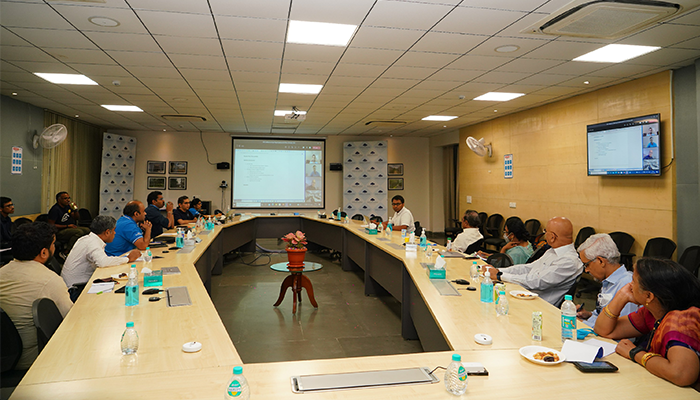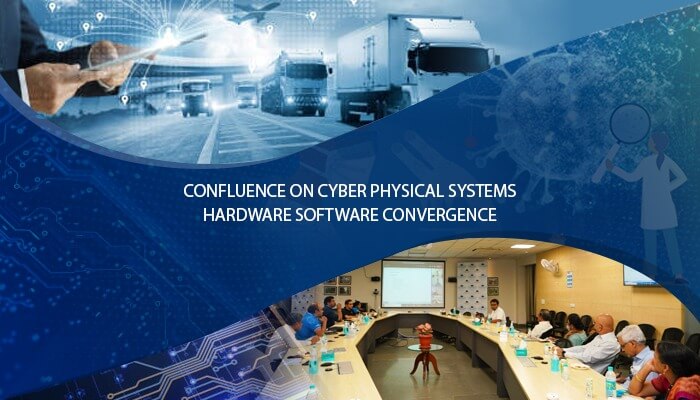As part of the R&D Showcase held in March, a confluence on Cyber Physical Systems, Hardware Software Convergence was held by IIITH and the Smart City Living Lab, that has been set up by MeITy and the National Smart City Mission. Here’s a brief summary of the discussions that transpired.
Like the name suggests, a cyber physical system or CPS is essentially a mix of the two – something physical, say any device, and a computer system that operates the device itself. Robots, intelligent buildings, self-driving cars, and more are all examples of CPS. With engineered computing and communicating systems interfacing the real world, CPS is an emerging discipline that has generated interest not just among the industry and academia but among the government as well. Hence there exists a National Mission on Interdisciplinary Cyber Physical Systems program. A brain-storming session on ‘Cyber Physical Systems – The Hardware Software Convergence’ which was organised by IIITH saw industry leaders, innovators, technologists, and researchers listing its use cases along with the technology challenges that such a hardware and software convergence are likely to face.
Ubiquity of CPS
The digital twin concept is a popular one where a virtual counterpart of the actual physical object is created to view the status of the physical object. Since a digital twin can be used for monitoring and diagnostics as well, the use of it for predictive maintenance across industries was discussed. There’s a growing demand for smart meters which rely on this concept – for gas, electricity and water – especially in the Indian context thanks to their lower power consumption. For road safety, one of the direct applications is the way in which vehicles are embedded with systems generating collision alerts well before an accident takes place. Collected data is also helpful in generating analytics for predicting accidents based on area and time of the day. CPS is also used in consumer electronics and can be found extensively in home automation systems such as smart locks and smart security systems. In addition to this, it has found widespread usage in the wearables industry – for medical monitoring or general fitness. In the defence sector, one of the biggest challenges is in making existing legacy systems autonomous. For instance, scenarios were explored where fewer personnel would be necessary for manning artillery and other equipment with the able assistance of autonomous systems. In the field of education too, CPS can be used by the setting up of remote labs where students from across the country can access them 24X7.

Challenges Galore
The group laid out the issues that cyber physical systems currently face and bandied forth probable solutions. One of them is ensuring that every CPS-embedded device is unique. For that, it is imperative to use a physical unclonable function such as the setting up of fingerprints as one of the non-functional requirements. Estimating infrastructure requirements for accurate AI interfacing is another problem plaguing CPS. Specialised hardware – with high power requirements as well as specialised software is required to deploy models running at a certain speed. Another challenge faced by CPS is the lack of continuous training of AI models and continuous interference from the data collected. The panelists were of the opinion that the AI models need to be built, modified, and deployed like any other hardware. CPS is often synonymous with IoT because they work together to accelerate progress in a variety of domains and industries. Both require sensors but unfortunately most of the sensors deployed are imported either from China or the US. In order to scale CPS in a secure fashion, Indian-made low-cost sensors are needed. Buying technology is expensive. Besides, it keeps evolving even as we speak and upgrading is a huge challenge. Alternatives to buying or renting tech need to be thought through to minimise costs.
Glitches to Convergence
When hardware and software converges, the magic happens in CPS. However there are obvious challenges associated with this. While devices today are more focused on bandwidth, more network, low power, low cost computing and so on, security is an issue that is often ignored but one that comes along with the deep learning algorithms. Another question that was posed was about the emergence of edge computing and how it needs to be pursued. Machine learning and deep learning models are already a part of CPS systems but since the ML space is constantly evolving, when they converge, there will be a gap in structure. For this, new-age tools need to be explored.
Building An Ecosystem
The International Institute of Information Technology Hyderabad took cognisance of the use cases listed under various domains for CPS and the challenges that currently mar the smooth convergence of hardware and software. With the cyber physical systems field gaining sufficient traction and its technology being applied across various domains, investment in developing an ecosystem was mooted along with inviting more collaboration between industry and academia for the future of CPS in India.

Sarita Chebbi is a compulsive early riser. Devourer of all news. Kettlebell enthusiast. Nit-picker of the written word especially when it’s not her own.


Next post